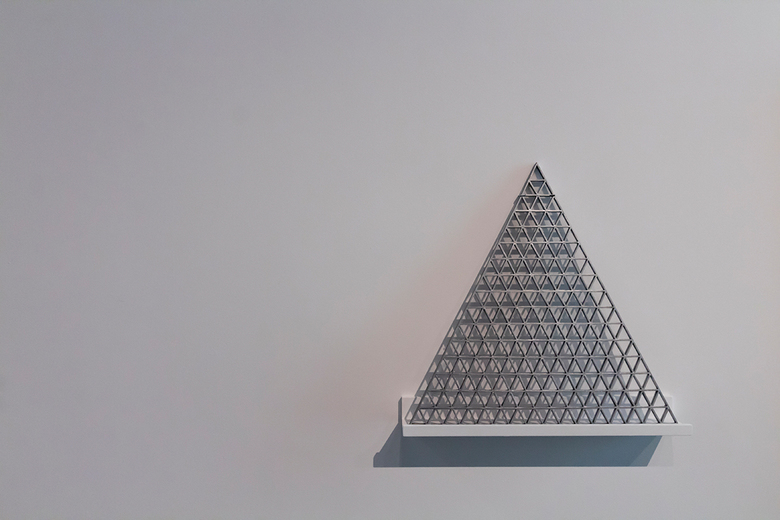The Pyramids of Agnes Denes
Model for The Human Argument in Steel & Crystal With Sundial, ca. 1982-84 (All photos by John Hill/World-Architects)
Artist Agnes Denes is best known for the two-acre wheat field she planted and sowed in 1982 on landfill in Lower Manhattan, what would later become Battery Park City. But a large-scale retrospective now at The Shed displays, among other things, her predilection for pyramids, including one specially commissioned for the exhibition.
Agnes Denes: Absolutes and Intermediates (October 9, 2019 – January 19, 2020) is billed as the first major retrospective on the Budapest-born artist in New York City, the city she has called home for around 50 years. Curated by The Shed's Emma Enderby, the exhibition presents more than 150 works on two floors of the new cultural venue at Hudson Yards designed by Diller Scofidio + Renfro with Rockwell Group.
Denes has always been comfortable interacting with the built and natural environments, be it directly as in the famed Wheatfield–A Confrontation or metaphorically through her many drawings and models. Her large-scale proposals, such as an in-progress project for "mega-dunes" and barrier islands at New York's Rockaways, offer what she describes as "benign solutions" to ecological and humanitarian crises. Veering into the scales of architecture and landscape architecture, it's no surprise her work appeals to architects and landscape architects.
Visitors to the exhibition first take escalators or elevators up the fourth floor, where the bulk of her career-spanning artworks are found. Later, they descend to the second floor, which is dedicated to the 88-year-old artist's ongoing "Pyramid Series." Yet as our photos from a press preview the day before the opening attest, the pyramids are not limited to the second floor; they are scattered about the fourth floor as well, illustrating her preoccupation with this basic geometric form over the course of her long career.


Partitions of plaster and scrim divide up the large gallery space on the fourth floor. Wheatfield–A Confrontation is visible at right, while in the distance is a neon artwork we'll get a closer look at soon.
One area is devoted to the "Map Projections" series from the 1970s, in which Denes used isometric projection to distort the Earth into various forms: an egg, a doughnut, a cube, even a hot dog.
Here are two iterations of Isometric Systems in Isotropic Space – Map Projections: The Pyramid where our planet is distorted into a pyramid.
At the far end of the gallery is the only splash of color in the exhibition design by New Affiliates; a glowing blue-purple wall hints at something special out of sight.
The Human Argument IV–Light Matrix (1987/2012), seen in our first glimpse of the fourth-floor gallery, is a 6-foot-tall pyramid that has been mounted to a wall next to a special gallery accessed through a curtain.
Inside are sculptures, including The World of Thorns (1968), a cubic construction of acrylic that nevertheless sees a repeated pyramidal form in the box's reflective surfaces.
Downstairs, the second-floor is laid out symmetrically, with three rows of staggered walls framing two of three pieces specially commissioned by The Shed (the third, Model for A Forest for New York, is upstairs).
The first of the two new commissions located on the gallery's central axis is Model for Teardrop—Monument to Being Earthbound, based on a drawing in Denes's "Pyramid Series" from 1984. The second, Model for Probability Pyramid—Study for Crystal Pyramid, is visible in the distance.
The artist's original Teardrop depicted a monumental teardrop-shaped sculpture "levitat[ing] above the center of the base afloat on an elastic cushion of magnetic flux." Impossible then and now, a scale version magically floats on a table top in the middle of the gallery.
At the far end of the gallery is Model for Probability Pyramid—Study for Crystal Pyramid, seen here alongside a roughly 40-year-old drawing that the model is based upon.
The Reflection (1981) is one of many drawings on the walls flanking the model that convey how Denes is a skilled draftsperson.
Unlike the Egyptian pyramids, Model for Probability Pyramid—Study for Crystal Pyramid ascends to its 17-foot-tall peak in curved lines rather than straight lines, an expression of a mathematical formula she explored 45 years ago.
Pascal's Triangle, no. 3 (1974), a huge drawing 16 feet long (almost as tall as the model at the other end of the gallery), reveals on exploration, in which "each line of this pyramid of binomial coefficients is constructed by writing the sum of each pair of adjacent numbers of the line above and putting '1' at each end," according to Denes. A nearly 23-foot-tall pyramid would yield a base one mile long.
Model for Probability Pyramid—Study for Crystal Pyramid, illuminated from within, is made from nearly 6,000 corn-based, 3D-printed bricks, meaning the installation could be composted after the exhibition is done.














